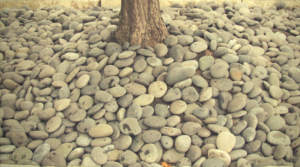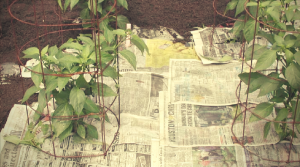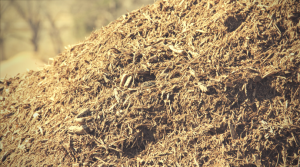Mulching Guide
Mulching is the covering of the plants in soil around ornamental and vegetable garden with a layer of organic material. Mulching improves soil structure, helps control weeds, provides a permanent power supply layer and insulates against heat and cold.
Benefits of Mulch
Let us explore some benefits of mulching:
- Prevents soil erosion – Soil erosion happens when winds or water slowly wear away the surface of soil and remove it. Mulching your soil will prevent this as there is now a protective, replaceable layer.that comes between the surface of the soil and the forces of nature above it.
![]() Insulates the soil in winter – The harsh temperatures of winter can be unkind. Mulching the soil in winter will insulate the soil preventing it from repeated patterns of freezing and thawing and will insulate plant roots. It prevents heaving (buckling upward) of soil in spring. Mulch should be applied to the soil when it has frozen and removed in spring only when there is no danger of further frosts. Winter-mulched soil thaws out more quickly in the spring.
Insulates the soil in winter – The harsh temperatures of winter can be unkind. Mulching the soil in winter will insulate the soil preventing it from repeated patterns of freezing and thawing and will insulate plant roots. It prevents heaving (buckling upward) of soil in spring. Mulch should be applied to the soil when it has frozen and removed in spring only when there is no danger of further frosts. Winter-mulched soil thaws out more quickly in the spring.- Cools down soil in summer – A layer of mulch in summer protects the soil beneath from the extreme heats of summer and reduces the need for constant watering i.e. water retention is improved.
- Helps against soil compaction – The layer of mulch acts as a buffer or extra layer between entities that can cause compaction on the soil below e.g. people, equipment, heavy rains.
- Improves appearance – A mulch applied to your bed can make it look more complete and attractive. This varies from mulch to mulch as some are more attractive and natural looking than others.
- Prevents weed growth – One of the more useful benefits of mulching is in weed prevention. While the mulch itself will not stop weeds from germinating it serves to act as a barrier between the weeds and the outside world above. When a weed reaches the mulch layer it will not be able to break above it and it will eventually die back. Some mulches perform this weed prevention feature better than others. Depth of mulch is also a contributing factor. Care should be taken however when selecting mulches as some mulches like grass clippings and straw may actually contain weed seeds.
- Keeps fruit and vegetables clean – A layer of mulch reduces the chances of fruit and vegetables getting dirty from splashes from the soil below.
Why mulching?
Mulching is good for your plants and good for the soil. And for the environment you are used namely for garden waste. The advantages.
Weed control
The layer of organic material inhibits the growth of weeds. If there is still knows what weeds germinate, it is easy to pull it out of the loose top layer.
Insulation and protection
Mulch covers the bottom and thus forms a layer of insulation against heat and cold. Frost draws less easily into the soil and strong sunlight does not penetrate to the bottom through which moisture is better retained. Raindrops fall directly on the ground, but first on the mulch. The soil is not too compacted by heavy raindrops and nutrients wash not just leave.
Nutrition and soil structure
Soil organisms feed on the mulch layer and put it in humus and moisture which in turn food for soil and plants. The soil structure improves soon after you start mulching. Even hard surfaces change in loose, fertile soil full of oxygen and nutrients.
Less garden waste
You use your garden waste for mulch and that means considerably less waste.
Check out this post to ensure your mulch isn’t damaging your landscaping
Choosing the Correct Mulch for Your Garden
Careful thought should be given when choosing a mulch to apply to your garden as each is different and should fit in with your exact requirements.
Here are some common factors that should be considered:
- Soil pH suitability – Some mulches like bark mulch and pine needle mulch can affect the pH value of soil so they are best used on soils containing acid-loving plants.
- Removal in spring – Certain mulches need to be removed in spring because they can smother emerging plants. Examples include stone mulch and bark chips.
- Cost – Is cost a limiting factor in your choice of mulches? If so you can find your mulch for free if you choose certain types. If you keep a compost heap then you will have compost for mulching. Other free mulches (if you have the sources) are pine needles and grass clippings.
- Appearance – Do you care about how the bed will look when the mulch is applied? Each mulch adds a different look and depending on the design of your garden you may want to choose a mulch that matches it in colour and texture.
- Penetration by water and air – Some mulches are better at allowing water and air to pass through them than others. This may be important depending on a plant’s watering requirements.
- Addition of nutrients to the soil – Organic mulches add nutrients back into the soil when they decompose. The nutrient types and their amounts added back into the soil depend on the mulch and it varies quite a bit. Using compost as a mulch guarantees plenty of nutrients for your plants.
When and how to Mulch?
Mulching do almost all year. In the summer protects against dryness and heat in the fall from too much rain, and in winter it keeps the worst frost in the ground. Only from early March to mid-May you cover the bottom no better. That’s the time that the soil needs to warm to germinate new plants. In early March so you take away the mulch. Use that old low as nice start for a new compost pile. Half or the end of May you go cover the ground again.
Start with thin and light layers between your emerging plants. Grass clippings is a perfect start low. Later, when the plants are stronger you going to hesitate a little less caution. The layer may be thicker and it is not very more if something gets on the plants, the wind blows it off there again. Work well with thin layers at a time, it should not go brew too much. Vary take some of the material you are using. By increasing the soil, the mulch breaks down faster. So stay supplement.
Mulching
 There are various types of mulch. Below you can read the different variants.
There are various types of mulch. Below you can read the different variants.
Grass and hay
Do you have a lawn? Then use the clippings to mulch. There are special mulching the grass finely cut . This is perfect to start your mulch layer, but later fill the layer with other materials. Incidentally, you can also make your lawn clippings lie of the mulching mower. The fine pieces pockets between the blades of grass and cover as the base of your turf. The composts and take the grass roots again nutrients. Also hay (dry grass) is a good material to create an airy layer
Leaves
Collect fallen leaves and pruned on your lawn and mow it with the mulching mower. Mixed with grass they form a fine layer.

Herbs
A mulch layer with a double feature you get with some herbs . Especially if you suffer from annoying insects in your garden you mix oregano, sage, mint, coriander and lavender . Insects are put by the smell of the herbs on the wrong track and let your crops alone.
Straw
Use straw especially in the summer months around like your strawberries . That means not only against weeds, but it also prevents low-hanging fruit lie rotting on the ground.
Newspapers
Even newspapers are adapted to cover and weeds to keep away for a long time you soil. Especially useful for vegetables which are further apart such as pumpkins. Put on the newspapers a layer of grass or compost so they do not blow away. The newspapers disappear again, because earthworms eat them.
 Wood chips and bark
Wood chips and bark
Wood, branches and bark can create a mulch if you make rather small shreds of a chopper. Especially suitable material for the ornamental garden.
Compost
Also, compost is a good mulch between your plants. Coat or even empty beds in your garden.
Stone
Looks great and provides great insulation. If removal in spring is a factor in your choice of mulch avoid using stone. Degrades very, very slowly. Apply to a depth of 2 – 4 inches.
Plastic
 Does not decompose so it does not add anything into the soil. Acts as a great weed control and is easily laid. Must be perforated to allow water to pass through. Apply in a thickness of 1 – 6 mm.
Does not decompose so it does not add anything into the soil. Acts as a great weed control and is easily laid. Must be perforated to allow water to pass through. Apply in a thickness of 1 – 6 mm.
Geotextile
Expensive blanket-like synthetic fiber that provides great weed control and allows for water penetration. Almost always used in conjunction with a cover mulch (e.g. bark chips). Apply in a single layer.
Sow in mulch
Before you start sowing or planting push aside the mulch layer first. After planting, lay the mulch back, wait again after sowing until the plants are big enough.



 Insulates the soil in winter – The harsh temperatures of winter can be unkind. Mulching the soil in winter will insulate the soil preventing it from repeated patterns of freezing and thawing and will insulate plant roots. It prevents heaving (buckling upward) of soil in spring. Mulch should be applied to the soil when it has frozen and removed in spring only when there is no danger of further frosts. Winter-mulched soil thaws out more quickly in the spring.
Insulates the soil in winter – The harsh temperatures of winter can be unkind. Mulching the soil in winter will insulate the soil preventing it from repeated patterns of freezing and thawing and will insulate plant roots. It prevents heaving (buckling upward) of soil in spring. Mulch should be applied to the soil when it has frozen and removed in spring only when there is no danger of further frosts. Winter-mulched soil thaws out more quickly in the spring.
Comments are closed, but trackbacks and pingbacks are open.